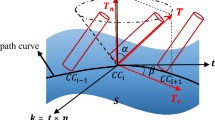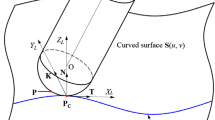Abstract
Parts with free-form surfaces exhibit a complex structure and are difficult to process. The processing quality of such surfaces determines the performance and service life of the product. Tool orientation is vital for ensuring five-axis computer numerical control (CNC) machining efficiency and accuracy. Unlike the ball-end tool, the bull-nose tool (the bull-nose cutter) can adapt to the curvature change of the machined free-form surface and achieve superior machining quality because of its special geometry. A novel tool orientation optimization method based on the best curvature matching was used to fully exploit the advantages of the bull-nose tool. First, the relationship between the evaluated scallop height and the normal evaluation curvature was obtained for an arbitrary CC point. A curvature matching model was developed to evaluate the degree of matching between the tool and workpiece on the evaluation plane. Subsequently, based on the analysis of the effect of the tool type and orientation on curvature matching, a tool orientation optimization method based on the best curvature matching was proposed. Finally, the proposed optimization method was verified by performing a machining experiment of the free-form surface. The results revealed that the proposed method reduced the scallop height by 68.62%. The obtained results revealed that the proposed method could improve machining quality. Thus, the method exhibits high potential in engineering applications.


















© 5-axis measurement system employed to measure the machined surface

© 5-axis measurement system on each surface. (a) Surface #1, (b) Surface #2, (c) Surface #3
Similar content being viewed by others
Data availability
All data and materials are fully available without restriction.
Code availability
Not applicable.
References
Li Z, Tang K (2021) Partition-based five-axis tool path generation for freeform surface machining using a non-spherical tool [J]. J Manuf Syst 58:248
Huo G, Jiang X, Su C et al (2019) CNC Tool path generation for freeform surface machining based on preferred feed direction field[J]. Int J Precision Eng Manuf 20(5):777–790
Lasemi A, Xue D, Gu P (2010) Recent development in CNC machining of freeform surfaces: a state-of-the-art review[J]. Comput-Aided Des 42(7):641–654
Tunc LT (2019) Smart tool path generation for 5-axis ball-end milling of sculptured surfaces using process models[J]. Rob Comput-Integ Manuf 56:212–221
Wang YP, Xu JT, Sun YW (2021) Tool orientation adjustment for improving the kinematics performance of 5-axis ball-end machining via CPM method[J]. Rob Comput-Integ Manuf 68:102070
Xu K, Li Y (2019) Region based five-axis tool path generation for freeform surface machining via image representation[J]. Rob Comput-Integ Manuf 57:230–240
Zhan D, Jiang S, Niu J et al (2020) Dynamics modeling and stability analysis of five-axis ball-end milling system with variable pitch tools [J]. Int J OF Mech Sci 182:105774
Ji YJ, Wang XB, Liu ZB et al (2019) Stability prediction of five-axis ball-end finishing milling by considering multiple interaction effects between the tool and workpiece[J]. Mech Syst Signal Process 131:261–287
Warkentin A, Ismail F, Bedi S (1998) Intersection approach to multi-point machining of sculptured surfaces[J]. Comput Aided Geometric Des 15(6):567–584
Warkentin A, Ismail F, Bedi S (2000) Comparison between multi-point and other 5-axis tool positioning strategies[J]. Int J Mach Tools Manuf 40(2):185–208
Warkentin A, Ismail F, Bedi S (2000) Multi-point tool positioning strategy for 5-axis mashining of sculptured surfaces[J]. Comput Aided Geometric Des 17(1):83–100
Zhang X, Zhang J, Zheng X et al (2017) Tool orientation optimization of 5-axis ball-end milling based on an accurate cutter/workpiece engagement model[J]. Cirp J Manuf Sci Technol 19:106–116
Shamoto E, Akazawa K (2009) Analytical prediction of chatter stability in ball end milling with tool inclination[J]. CIRP Ann 58(1):351–354
Liang F, Kang C, Fang F (2020) A review on tool orientation planning in multi-axis machining [J]. Int J Prod Res 59(18):5690–5720
Jensen CG, Red WE, Pi J (2002) Tool selection for five-axis curvature matched machining[J]. Comput-Aided Des 34(3):251–266
Du J, Yan X-G, Tian X-T (2012) The avoidance of cutter gouging in five-axis machining with a fillet-end milling cutter[J]. Int J Adv Manuf Technol 62(1–4):89–97
Lin T, Lee J-W, Bohez ELJ (2009) A new accurate curvature matching and optimal tool based five-axis machining algorithm[J]. J Mech Sci Technol 23(10):2624–2634
Luo S, Dong Z, Jun MBG (2017) Optimal tool orientation generation and chip volume/cutting force predictions for 5-axis CNC machining of curved surfaces using flat-end mills[J]. Comput-Aided Des App 14(3):331–342
Gong H, Cao LX, Liu H (2008) Second order approximation of tool envelope surface for 5-axis machining with single point contact[J]. Comput-Aided Des 40(5):604–615
Gong H, Fang FZ, Hu XT et al (2010) Optimization of tool positions locally based on the BCELTP for 5-axis machining of free-form surfaces[J]. Comput-Aided Des 42(6):558–570
Zhu LM, Ding H, Xiong YL (2010) Third-order point contact approach for five-axis sculptured surface machining using non-ball-end tools (I): third-order approximation of tool envelope surface[J]. Sci China-Technol Sci 53(7):1904–1912
Zhu LM, Ding H, Xiong YL (2010) Third-order point contact approach for five-axis sculptured surface machining using non-ball-end tools (II): tool positioning strategy[J]. Sci China-Technol Sci 53(8):2190–2197
Cao LX, Gong H, Liu J (2006) The offset approach of machining free form surface - part 1: cylindrical cutter in five-axis NC machine tools[J]. J Mater Process Technol 174(1–3):298–304
Cao LX, Gong H, Liu J (2007) The offset approach of machining free form surface - part 2: toroidal cutter in 5-axis NC machine tools[J]. J Mater Process Technol 184(1–3):6–11
Gong Z, Li BR, Zhang H et al (2022) Tool orientation optimization method based on ruled surface using genetic algorithm[J]. Int J Adv Manuf Technol 118(1–2):571–584
Yuan C, Mi Z, Jia X et al (2020) Tool orientation optimization and path planning for 5-axis machining[J]. J Syst Sci Complex 34(1):83–106
Zou X, Tam H-Y, Xu H-Y et al (2019) Flat-end tool orientation based on rotation-minimizing frame[J]. Adv Manuf 7(3):257–269
Xu J, Zhang D, Sun Y (2019) Kinematics performance oriented smoothing method to plan tool orientations for 5-axis ball-end CNC machining[J]. Int J MechSci 157:293–303
Huang T, Zhang X, Leopold J, Ding H (2018) Tool orientation planning in milling with process dynamic constraints: a minimax optimization approach. ASME J Manuf Sci Eng 140(11):111002. https://doi.org/10.1115/1.4040872
Xiao QB, Wan M, Zhang WH et al (2022) Tool orientation optimization for the five-axis CNC machining to constrain the contour errors without interference[J]. J Manuf Process 76:46–56
Zhou K, Tang J (2020) Tool position and orientation global optimization intrinsic geometry of strip-width-maximization manufacture technology for sculptured surface[J]. J Mech Eng 56(11):192–201
Duan X, Peng F, Zhu K et al (2019) Tool orientation optimization considering cutter deflection error caused by cutting force for multi-axis sculptured surface milling[J]. Int J Adv Manuf Technol 103(5–8):1925–1934
Zhu Y, Chen Z-T, Ning T et al (2016) Tool orientation optimization for 3+2-axis CNC machining of sculptured surface[J]. Comput-Aided Des 77:60–72
Habibi M, Tuysuz O, Altintas Y (2019) Modification of tool orientation and position to compensate tool and part deflections in five-axis ball end milling operations. ASME J Manuf Sci Eng 141(3):031004. https://doi.org/10.1115/1.4042019
Ezair B, Elber G (2018) Automatic generation of globally assured collision free orientations for 5-axis ball-end tool-paths[J]. Comput-Aided Des 102:171–181
Kim YJ, Elber G, Barton M et al (2015) Precise gouging-free tool orientations for 5-axis CNC machining[J]. Comput-Aided Des 58:220–229
Dong JL, Yu TB, Chen H et al (2020) An improved calculation method for cutting contact point and tool orientation analysis according to the CC points[J]. Precis Eng-J Int Soc Precis Eng Nanotechnol 61:1–13
He C, Zheng M, Yang S et al (2018) Tool path planning without interference for convex surfaces based on the optimal cutter orientation of the annular cutter[J]. Int J Inter Des Manuf - Ijidem 12(3):787–800
Zhao Jibin A, Zhong B, Zou Q et al (2013) Tool orientation planning for five-axis CNC machining of open free-form surfaces[J]. J Syst Sci Complex 26(5):667–675
Sun S, Sun Y, Lee Y (2019) A gouge-free tool axis reorientation method for kinematics compliant avoidance of singularity in 5-axis machining. ASME J Manuf Sci Eng 141(5):051010. https://doi.org/10.1115/1.4043266
Lin Z, Fu J, Yao X et al (2015) Improving machined surface textures in avoiding five-axis singularities considering tool orientation angle changes[J]. Int J Mach Tools Manuf 98:41–49
Segonds S, Seitier P, Bordreuil C et al (2019) An analytical model taking feed rate effect into consideration for scallop height calculation in milling with torus-end cutter[J]. J Intel Manuf 30(4):1881–1893
Funding
This work received financial support from the National Natural Science Foundations of China (Grant Nos. 51775445 and 52175435), Defense Industrial Technology Development Program (No. XXXX2018213A001), and Shaanxi Province Major R&D Project (No. 2021ZDLGY03-07).
Author information
Authors and Affiliations
Contributions
All authors contributed to the design and implementation of the concept. Jieshi Dong: conceptualization, methodology, experimental design, writing-original draft preparation; Peng Chen, Jinming He, and Neng Wan: investigation, experiment, data processing, and analysis; Zhiyong Chang: writing review and editing. All authors connected on previous versions of the manuscript and have read and approved the final manuscript.
Corresponding author
Ethics declarations
Ethics approval
Not applicable.
Consent to participate
Not applicable.
Consent for publication
Not applicable.
Competing interests
The authors declare no competing interests.
Additional information
Publisher's note
Springer Nature remains neutral with regard to jurisdictional claims in published maps and institutional affiliations.
Rights and permissions
Springer Nature or its licensor (e.g. a society or other partner) holds exclusive rights to this article under a publishing agreement with the author(s) or other rightsholder(s); author self-archiving of the accepted manuscript version of this article is solely governed by the terms of such publishing agreement and applicable law.
About this article
Cite this article
Dong, J., Chang, Z., Chen, P. et al. Tool orientation optimization method based on the best curvature matching. Int J Adv Manuf Technol 124, 127–142 (2023). https://doi.org/10.1007/s00170-022-10526-3
Received:
Accepted:
Published:
Issue Date:
DOI: https://doi.org/10.1007/s00170-022-10526-3




